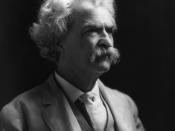The Connection between Critique and Fiction
According to William Dean Howells, "Realism is nothing more and nothing less than the truthful treatment of material." Realism sometimes refers to the time between the American Civil war and the turn of the century. Much like the times of confusion and upheaval post Civil war, there was this same confusion in the literary world regarding the use of Romanticism vs. Realism. As the United States tried to shift from a country that practiced slavery to a country without, the citizens of the United States had to adjust to shift in the style of writing. During these vulnerable years, the realistic writing style took center stage by appealing to the common man. This new realistic writing style made them aware of the stimulation of their senses with reading. Two of the prominent writers during this time were Mark Twain and William Dean Howells. Howells and Mark Twain are considered by some to be the fathers of American Realism. The following essay will attempt to use Howells' observations of literature and apply them to Mark Twain's piece "The Man that Corrupted Hadleyburg."
In order to properly scrutinize this piece, one must first establish what exactly Howells was saying is his critique. The first main principle is that a "true standard of art is in every mans power". In this statement, he is saying that the common man, regardless of education or color, has the ability of finding art and that art is in the eye of the beholder. His graphic illustration of the grasshopper is a prime example of this premise. Howells proceeds to go into an elaborate description of the grasshopper-- then tells his readers that things are not always what they seem. "the ideal grasshopper wherever he finds itâ¦is...


